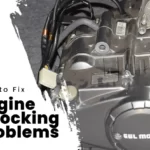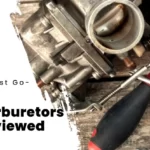Are you ready for an exciting day of go-kart racing, but your trusty kart won’t start? Don’t let the fun come to a screeching halt! This comprehensive guide will dive into the most common issues that might keep your go-kart from starting and provide practical solutions to get you back on track in no time.
We have you covered, from spark plug problems to carburetor issues and everything in between. So buckle up, and let’s troubleshoot your go-kart to bring it back to life!
Related Article: Best Go-Kart Engines
1. Spark Plug Issues
Problem: Spark plugs that are worn out or damaged will fail to produce the spark needed for ignition, while improperly sized spark plugs may not fit correctly and cause performance issues.
Solution: First, locate the spark plug and remove it using a socket wrench. Inspect the spark plug for wear, cracks, or damage. Look for signs of carbon buildup, which could indicate a fouled spark plug. If the spark plug is damaged, replace it with a new one. Check your engine specifications to ensure it’s the correct size and type for your go-kart.
2. Insufficient or Stale Fuel
Problem: If there isn’t enough fuel in the tank, your engine won’t start. Stale fuel, which can occur if your go-kart has been sitting for an extended period, may also cause starting issues due to the loss of volatile components.
Solution: Check your fuel level by visually inspecting the tank or using a fuel gauge. If it’s low, add fresh fuel, referring to a go-kart fuel mixture chart if necessary. Drain and refill the fuel tank with fresh fuel to address stale fuel. You might also consider adding a fuel stabilizer to prevent fuel degradation in the future.
3. Wrong Engine Configuration
Problem: The engine won’t start if the kill switch is engaged or the choke settings are incorrect, as these settings control fuel and air intake.
Solution: Verify that the kill switch is in the “run” position, which typically disengages the electrical circuit and allows the engine to start. Check the choke settings and adjust them according to your engine’s specifications, as found in the owner’s manual or on the manufacturer’s website.
Generally, you’ll want the choke in the “closed” position to start a cold engine and the “open” position for a warm engine. Experiment with the choke settings if you’re unsure of the optimal configuration.
4. Electrical Problems
Dead or Weak Battery
Problem: A dead or weak battery can prevent the electric starter from turning the engine over, making it impossible to start.
Solution: Check the battery voltage using a multimeter. Recharge or replace the battery if the voltage is below the recommended level. Ensure the battery connections are clean and tight. For a weak battery, it might be helpful to use a battery maintainer to keep it charged when the go-kart is not in use.
Faulty Wiring or Connections
Problem: Damaged or disconnected wires can prevent power from reaching the starter, ignition coil, or other essential components.
Solution: Inspect the wiring harness for any visible damage, such as frayed or melted wires, and check for loose or disconnected connections. Repair or replace any damaged wires and reconnect any loose connections. Consider consulting a professional mechanic if you’re uncomfortable working with electrical systems.
5. Air Intake and Carburetor Issues
Dirty or Clogged Air Filter
Problem: A dirty or clogged air filter can restrict airflow to the carburetor, preventing the engine from starting.
Solution: Locate the air filter, remove it from the airbox, and inspect it for dirt, debris, or damage. Clean the filter gently, tapping it on a hard surface or using compressed air to remove debris. If it’s significantly dirty or damaged, replace the air filter with a new one.
Clogged or Maladjusted Carburetor
Problem: A clogged carburetor can cause fuel starvation, while a maladjusted carburetor can create an incorrect air-fuel mixture, preventing the engine from starting.
Solution: Remove the carburetor from the engine following the manufacturer’s guidelines. Disassemble the carburetor, clean its components with carburetor cleaner, and reassemble it. Inspect the fuel and air passages for blockages, and clean them if necessary. If the carburetor is maladjusted, refer to your owner’s manual for the proper adjustments or consult a professional mechanic.
You can get your go-kart running by identifying and addressing these common issues. Always consult your owner’s manual or the manufacturer’s website for detailed instructions on maintenance and repair for your specific go-kart model.
6. Engine Compression Issues
Worn or Damaged Piston Rings
Problem: Worn or damaged piston rings can cause poor engine compression, making it difficult or impossible for the engine to start.
Solution: Perform a compression test on the engine using a compression gauge. If the compression is significantly lower than the manufacturer’s specifications, you may need to replace the piston rings. This task can be pretty involved, so consider consulting a professional mechanic if you’re uncomfortable with engine disassembly and reassembly.
Faulty Valves
Problem: Faulty intake or exhaust valves can cause poor engine compression and prevent the go-kart from starting.
Solution: Inspect the valve train components for wear or damage. If you find any issues, replace the faulty components. This may involve removing the cylinder head and can be a complex task. Consult a professional mechanic if you’re not comfortable with this repair.
7. Ignition System Issues
Malfunctioning Ignition Coil
Problem: A malfunctioning ignition coil can prevent the spark plug from receiving the necessary voltage to create a spark, causing the engine to fail to start.
Solution: Inspect the ignition coil for visible damage, cracks, or corrosion. Test the coil’s resistance with a multimeter according to the manufacturer’s specifications. Replace the coil if it is damaged or outside the specified resistance range.
Damaged or Malfunctioning Ignition Switch
Problem: A malfunctioning ignition switch can prevent the engine from starting.
Solution: Inspect the ignition switch for visible damage or signs of wear. Test the switch with a multimeter, checking for continuity in various positions. If the switch is damaged or not functioning properly, replace it.
8. Timing Issues
Problem: Incorrect ignition timing can prevent the engine from starting or cause poor performance.
Solution: Check the ignition timing according to the manufacturer’s specifications using a timing light or other appropriate tools. Adjust the timing as necessary, following the guidelines in your owner’s manual or consulting a professional mechanic if you’re uncomfortable making these adjustments.
9. Carburetor Issues
Clogged Jets
Problem: Over time, debris and sediment can accumulate in the carburetor’s jets, preventing the correct air-fuel mixture from entering the engine and making it difficult or impossible to start.
Solution: Remove the carburetor and carefully disassemble it. Clean the jets with carburetor cleaner, thin wire, or jet cleaning tool. Reassemble the carburetor and reinstall it on the engine. If the jets are severely clogged or damaged, they may need to be replaced.
Related Article: How to Fix a Go-Kart Carburetor Leaking Gas
Incorrect Carburetor Adjustment
Problem: An improperly adjusted carburetor can cause poor performance or prevent the engine from starting.
Solution: Refer to our article Go-Kart Carburetor Adjustment Guide. You may need to adjust the idle speed, mixture screw, or both to achieve the correct air-fuel mixture. If you’re unsure about making these adjustments, consult a professional mechanic.
10. Exhaust System Issues
Problem: A blocked exhaust system can cause poor engine performance or prevent the engine from starting. The buildup of debris, rust, or even a damaged muffler can obstruct the flow of exhaust gases.
Solution: Inspect the exhaust system for blockages or damage. You may need to remove the muffler or exhaust system to check for obstructions. Clean out any debris and replace damaged components as needed.
11. Loose or Damaged Drive Belts
Problem: Loose or damaged drive belts can cause a go-kart’s engine not to start or lead to poor performance.
Solution: Inspect the drive belts for damage, wear, or improper tension. If the belt is damaged or worn out, replace it. If the belt is loose, adjust the tension according to the manufacturer’s specifications.
Related Article: How to Put a Belt on a Go-Kart
12. Vacuum Leaks
Problem: Vacuum leaks in the intake manifold, carburetor, or other engine components can cause poor engine performance and starting issues.
Solution: Inspect the engine for potential vacuum leaks by visually checking for cracked, damaged, or disconnected hoses and gaskets. You can also use a carburetor cleaner spray to check for leaks by spraying around the suspected areas while the engine is running. If the engine’s idle changes when you spray, it indicates a vacuum leak. Replace or repair the damaged parts as needed.
13. Overheating Issues
Problem: If a go-kart’s engine has overheated in the past or is currently overheating, it might fail to start.
Solution: Inspect the cooling system components, such as the radiator, coolant levels, and cooling fan, for any signs of damage or malfunction. Repair or replace damaged parts and ensure that the coolant is at the proper level. Check for any signs of coolant leaks and address them as necessary.
14. Damaged Starter Motor
Problem: A damaged or worn-out starter motor can prevent the engine from turning over and starting.
Solution: Inspect the starter motor for visible damage, such as worn gears or burnt wiring. Test the starter motor using a multimeter or other appropriate tools to verify its proper operation. If the starter motor is faulty, replace it.
15. Valve Lash Adjustment:
Problem: Improperly adjusted valve lash can cause poor engine performance and prevent the engine from starting.
Solution: Refer to the manufacturer’s guidelines for the correct valve lash adjustment procedure. Use a feeler gauge to check the clearance between the valve stem and rocker arm and adjust it according to the manufacturer’s specifications.
Adding these additional problems and solutions will further enhance the comprehensiveness of your guide on diagnosing and fixing go-kart starting issues.
Conclusion
A go-kart that refuses to start can be a frustrating experience, but with this comprehensive guide, you are now well-equipped to diagnose and fix a wide range of issues. By following the practical solutions we’ve provided for common problems such as spark plug, fuel, electrical, air intake, carburetor issues, and more, you can identify the cause and remedy it quickly.
Always consult your owner’s manual or the manufacturer’s website for maintenance and repair instructions for your go-kart model. With patience and perseverance, you’ll have your go-kart roaring back to life, ready to provide endless hours of adrenaline-pumping fun on the track!

Goran, an experienced go-kart racer, fuels GoKartLife.com with his passion and expertise. He offers valuable insights and tips for fellow enthusiasts, fostering the growth of the go-kart community. Join Goran at GoKartLife.com and immerse yourself in this exhilarating sport.
Last modified: February 16, 2025



